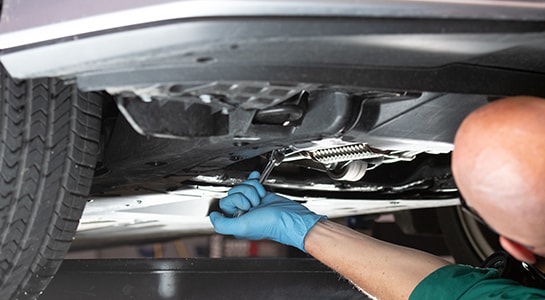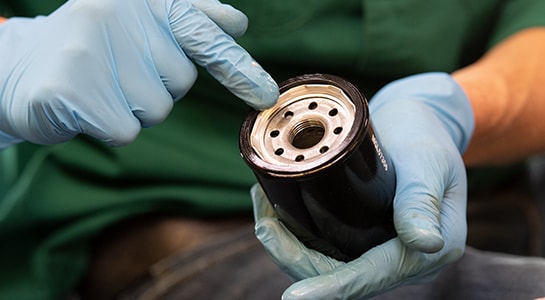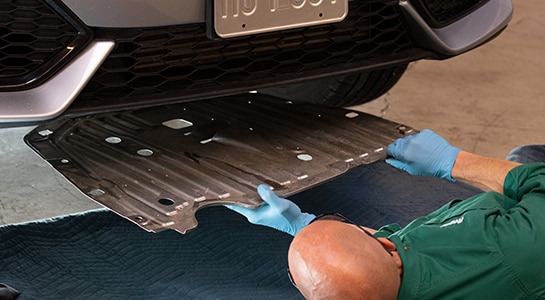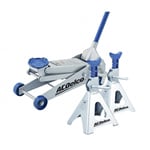We will be changing the oil in this 2019 Honda Civic, and procedures will be similar for any late-model Civic, but be sure to know the specifics for your vehicle before getting started. If you’re not completely comfortable doing the job yourself, we’d be happy to recommend a professional technician in your area.
- Home
- How To Hub
- How to Change Oil and Filter 2016-20 Honda Civic
How to Change the Oil and Filter on a 2016-2020 Honda Civic
Your Honda Civic’s oil filter helps trap and remove contaminants in the oil before it is recirculated throughout your vehicle’s engine. Changing your 2016-2020 Honda Civic’s oil and oil filter is a straightforward maintenance task that can improve your Honda's engine performance and longevity. Your Honda Civic’s oil filter should be replaced during each oil change, in addition to adding fresh oil. It’s recommended by most 2016-2020 Honda Civic owner’s manuals that you change your Civic’s oil and oil filter when the Oil Change Light illuminates on your dashboard, as your Honda is built with an oil life monitoring system that allows for variation in the oil change interval. Your Honda's service manual will detail the manufacturer’s maintenance intervals and the oil life indication system. A clogged oil filter or dirty oil can cause decreased engine performance, sputtering, metallic sounds from your Honda's engine, or may even cause the engine to seize. Our detailed instructions will help you perform an oil change on your Honda Civic.
Tools & Materials
Honda Civic Oil and Filter Change Instructions
Show More
Show Less
Drain the Old Oil

Step 1: Prepare the Vehicle
Start by running the engine until it reaches operating temperature, or until the fan comes on. Then turn off the engine. Raise and support the front end.
Show More
Show Less

Step 2: Remove the Under-Car Engine Plate
Remove the under-car engine plate by turning the eight fasteners counterclockwise and removing them.
Show More
Show Less

Step 3: Position the Drain Pan
Slide a drain pan into place under the drain bolt to catch the oil that will drain out.
Show More
Show Less

Step 4: Remove the Drain Bolt
Use your ratchet and socket to remove the drain bolt, and let the oil run out completely.
Show More
Show Less

Step 5: Clean the Area Around the Drain Bolt
Use a shop towel to wipe any excess oil from around the opening, as well as the drain bolt.
Show More
Show Less

Step 6: Reinstall the Drain Bolt
Discard the old washer and reinstall the drain bolt with a new washer. Tighten the drain bolt to 30 foot pounds.
Show More
Show Less
Remove the Old Oil Filter

Step 7: Loosen the Oil Filter
Locate the oil filter and use your filter wrench to loosen it.
Show More
Show Less

Step 8: Remove the Oil Filter
Finish removing it by hand and pour the oil from the filter into the drain pan.
|
Do It Right: Wipe down the area where the filter was threaded and make sure the old O-ring came off with the filter. |
Show More
Show Less
Install the New Oil Filter

Step 9: Lubricate the O-Ring
Lubricate the new O-ring with fresh oil.
Show More
Show Less

Step 10: Install the New Oil Filter
Thread the new filter into place by hand. Once the O-ring is against the oil pan, tighten the filter to 9 foot pounds.
Show More
Show Less
Refill the Oil

Step 11: Locate the Oil Fill Cap
Open the hood and locate the oil fill cap.
Show More
Show Less

Step 12: Refill the Oil
Refill the oil with the amount and type of oil recommended by the manufacturer. In our case, we’ll put in 3.7 quarts of 0W-20 for gasoline engines.
Show More
Show Less

Step 13: Check the Oil Level
Replace the oil fill cap and use the dipstick to check the oil level.
Show More
Show Less

Step 14: Test for Any Leaks
Start the engine and let it run for at least three minutes. Then, turn off the engine and check the oil level again. Make sure there aren’t any leaks. Once you’re sure there are no leaks, replace the under-car engine plate using the fasteners you removed earlier. It’s now safe to lower the vehicle and close the hood.
Show More
Show Less
Reset Your Maintenance Minder

Step 15: Reset Your Maintenance Minder
To reset the oil change notification on your Maintenance Minder, turn your vehicle to the ON position. If system messages are displayed, press the INFORMATION switch or Audio Remote/Multi-Information Display Switch to cancel the display until the “Maintenance Minder” icon is displayed, then press the “Source/Enter” button. The display should show the remaining engine oil life. Press and hold the “Source/Enter” button for ten seconds or more. The “Maintenance Reset” mode appears on the multi-information display.
Show More
Show Less
Additional Resources
These step-by-step instructions and video detail how to replace the oil filter in a 2016, 2017, 2018, 2019, and 2020 Honda Civic, and these instructions will be similar for select 2003, 2004, 2005, 2006, 2007, 2008, 2009, 2010, 2011, 2012, 2013, 2014, 2015, 2016, 2017, 2018, 2019, and 2020 Honda Odysseys, as well as 2003, 2004, 2005, 2006, 2007, 2008, 2009, 2010, 2011, 2012, 2013, 2014, 2015, 2016, 2017, 2018, 2019, and 2020 Honda Accords. Replacing the oil and oil filter removes contaminants from the oil before it is used to lubricate and cool your car’s engine components. Dirty oil, low oil levels, and a clogged oil filter can all cause engine damage, so ensure you perform the oil change on your Honda Civic within 500 miles of the oil life indicator light appearing. Your 2016-2020 Honda Civic’s owner’s manual will detail the service interval information, but if you notice a dirty or clogged oil filter or reduced engine performance, you can perform an oil and oil filter replacements more often to ensure a smooth-running engine and long-lasting performance.
Show More
Show Less
The automotive repair work depicted in this series is performed under the direction of the manufacturer of the product featured. Prior to undertaking any of the demonstrated repairs on your vehicle, we suggest you consult with a certified mechanic or another professional who can adequately advise you of the proper repair or remedy required. O’Reilly Automotive Stores, Inc. and its affiliates (“O’Reilly”) disclaims any responsibility for injury or damage resulting from a viewer’s attempt to recreate the repairs shown in this series.

 Safety Glasses
Safety Glasses
 Nitrile Gloves
Nitrile Gloves
 Drain Pan
Drain Pan
 Jack and Jack Stands
Jack and Jack Stands
 Motor Oil
Motor Oil
 Oil Filters
Oil Filters
 Filter Wrench
Filter Wrench
 Ratchet
Ratchet
 Sockets
Sockets
 Shop Towels
Shop Towels


